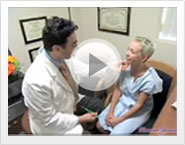My Philosophy
Introduction
I would like to sum up my entire book in two pages for you. If you only have 5 minutes you can read these pages and understand my motivation for writing this book and the message it entails.
After my dermatology residency at Mount Sinai Medical Center in New York I embarked on a year-long fellowship program to learn the different aspects of cosmetic surgery. I worked with brilliant surgeons from a variety of disciplines: facial plastic surgeons, general surgeons, plastic surgeons and ENT specialists. I received my training at a large and busy outpatient surgical clinic with two operating rooms, two recovery rooms, two hyperbaric oxygen chambers, ten examination rooms, staffed by forty nurses, physician assistants, and estheticians.
It was a rich and amazing experience that taught me a great deal of surgery. During the latter part of my training I witnessed what was going to become a life changing event. A patient undergoing a simple fat transfer procedure by another surgeon developed an adverse reaction to the general anesthesia and crashed. She stopped breathing and her heart had to be re-started by the emergency medical personnel pouring into the operating room. The surgeon hadn’t even started the surgery; the event was caused by an adverse reaction to the administered anesthesia.
The next 10 days were amongst the most difficult of my life. To see this young patient on life support fighting for her life changed the way I approach cosmetic surgery. I truly believe that her strong faith in God and the capable doctors at the Local Hospital saved her life. Miraculously, she fully recovered. I had to make a choice: give up my passion of becoming a great cosmetic surgeon or find a different and better way of doing surgery.
My salvation came in my understanding of Tumescent Liposuction which at that time had recently been introduced by Jeffrey Klein, MD. I believe that Dr. Klein single-handedly changed the entire field of cosmetic surgery and deserves endless credit. I learned that local anesthesia with or without a minimal amount of sedation can be used to do all types of cosmetic and plastic surgery.
I have spent the past 9 years perfecting just this: less invasive is better, local anesthesia and mild sedation is all that is ever needed. Patients want to look their best self, not someone else.
Most patients will choose local anesthesia if the surgeon spends the time and effort to explain why it is better, safer, and more cost effective. I truly believe that all types of cosmetic surgery can and should be performed under local anesthesia. In this book I will describe and show you results from thousands of procedures performed this way over the past 9 years. Many lives can be saved by performing cosmetic surgery under local anesthesia. There are still risks with administration of local anesthesia and the surgery: bleeding, infection, unsightly scars, etc. I believe these risks are much smaller and more manageable.
Finally, I want to mention that this book is not a criticism or attack of any group or society of surgeons. I understand that questioning the status quo will bring with it criticism of my surgical skills and me as a surgeon. I will be put under the loop because it will appear as if I am criticizing my fellow colleagues. This book, in no way, is meant to do that.
In this book I discuss liposuction, fat transfers, face and eyelifts, lasers, chemical peels, sclerotherapy and a variety of other procedures performed completely under local anesthesia. I do not discuss breast surgery, tummy tucks, or nose surgery. I do not perform these procedures but have seen them performed under local anesthesia as well. It takes longer for the surgeon to perform any surgery under local anesthesia and one can not do too may procedures at once. The patient is awake and care must be taken to numb the surgical area well. It also limits how much one can do at any given point. I discourage patients who want to do too much at the same time. I explain that a second or even third surgery may be necessary to address all their needs.
With this book I want patients to understand that they have a choice and can have most, if not all, cosmetic procedures under local anesthesia. I hope that my fellow colleagues will be open minded enough to give this approach a chance.
I urge you to proceed and read this book if what I have said has intrigued you. Thank you.
A. David Rahimi, MD, FAAD

